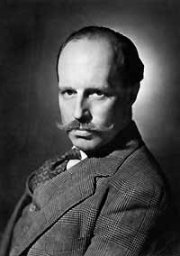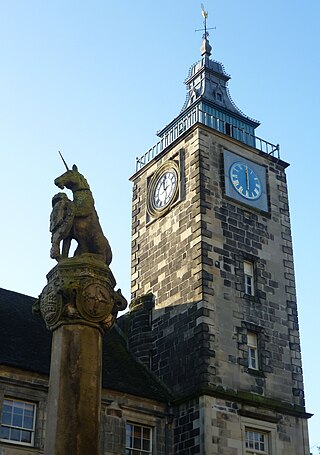Related Research Articles

Paisley is a large town situated in the west central Lowlands of Scotland. Located north of the Gleniffer Braes, the town borders the city of Glasgow to the east, and straddles the banks of the White Cart Water, a tributary of the River Clyde.

Sir Basil Urwin Spence, was a Scottish architect, most notably associated with Coventry Cathedral in England and the Beehive in New Zealand, but also responsible for numerous other buildings in the Modernist/Brutalist style.

The Hunterian is a complex of museums located in and operated by the University of Glasgow in Glasgow, Scotland. It is the oldest museum in Scotland. It covers the Hunterian Museum, the Hunterian Art Gallery, the Mackintosh House, the Zoology Museum and the Anatomy Museum, which are all located in various buildings on the main campus of the university in the west end of Glasgow.

John Caird DD LLD (1820–1898) was a Scottish theologian. He entered the Church of Scotland, of which he became one of the most eloquent preachers. He served as the Principal of the University of Glasgow from 1873 until 1898.

Benno Schotz was an Estonian-born Scottish sculptor, and one of twentieth century Scotland's leading artists.

The Radical War, also known as the Scottish Insurrection of 1820, was a week of strikes and unrest in Scotland, a culmination of Radical demands for reform in the United Kingdom of Great Britain and Ireland which had become prominent in the early years of the French Revolution, but had then been repressed during the long Napoleonic Wars.
Colin McIver Campbell is a Scottish politician and military historian. He was a Scottish National Party (SNP) Member of the Scottish Parliament (MSP) for West of Scotland region from 1999 to 2003. Campbell is a former history teacher and secondary school headmaster.
The 2007–08 Scottish Cup was the 123rd season of Scotland's most prestigious football knockout competition. The winners were Rangers, who defeated Queen of the South in the final.

Norman Macbeth was a Scottish portraitist.

Adam Bruce Thomson OBE, RSA, PRSW or ‘Adam B’ as he was often called at Edinburgh College of Art, was a painter perhaps best known for his oil and water colour landscape paintings, particularly of the Highlands and Edinburgh. He is regarded as one of the Edinburgh School of artists.

Joseph Swan was an engraver and publisher active in Glasgow in the early nineteenth century.

William Somerville Shanks ARSA, RSA, RSW was a Scottish artist who was a tutor in painting and drawing at the Glasgow School of Art for 29 years. His painting Tiddley Winks sold for £181,250 at Sotheby's in 2008, a record for the artist.
James Wallace Ferguson was a Scottish painter, born in Stirling, and resident in Glasgow for most of his life. He went to the Glasgow School of Art before the First World War. He won the Guthrie Award in 1923 for young artists of the Royal Scottish Academy. He became the President of the Glasgow Art Club in the 1950s. He also was a Principal Lecturer in Art at Jordanhill Teacher Training College. He died in New Zealand while staying with his son.
David Shanks Ewart was a Scottish painter, born in Glasgow. He went to the Glasgow School of Art just after the First World War. He won the Guthrie Award in 1926 with his work The Toilers.
Ian Campbell was a Scottish painter, born in Oban, Scotland. He won the Guthrie Award in 1931 with his work, the painting Self Portrait.
William Drummond Bone was a Scottish painter, born in Ayr. He won the Guthrie Award in 1939 with his work, the oil painting Leisure.
Sinclair Thomson was a Scottish painter, born in Glasgow, Scotland. He won the Guthrie Award in 1948 with his work, the oil painting The White Shawl.
William Smith Anderson was a Scottish painter. He is one of the McGlashan-Anderson artistic dynasty of the Glasgow School of Art.
William Cunningham Hector was a Scottish painter and antique collector. He is known for landscapes of Glasgow and surrounding area. In 1928 he bought Ethie Castle, just outside Arbroath.
References
- ↑ The Dictionary of Scottish Painters. 1600 to the present. Paul Harris and Julian Halsby. Canongate Publishing. 1990.
- 1 2 3 4 5 6 The Royal Scottish Academy Exhibitors 1826 - 1990. Charles Baile de Laperriere. Hilmarton Manor Press. 1991.
- ↑ Brown, Robert (18 October 1875). "The history of the Paisley Grammar School, from its foundation in 1576 : of the Paisley Grammar School and Academy and of the other town's schools". Paisley : A. Gardner – via Internet Archive.
- ↑ "Thomson Kirkwood (1820-1902) - Find a Grave..." www.findagrave.com.
- ↑ "The Laird's Loup, Kilsyth Glen | Art UK". artuk.org.
- ↑ "Gilmorehill from Woodland Road | Art UK". artuk.org.
- ↑ "Scottish Thomson Kirkwood oil on canvas of Narcissus (May post - ask?) | #539351594". Worthpoint.